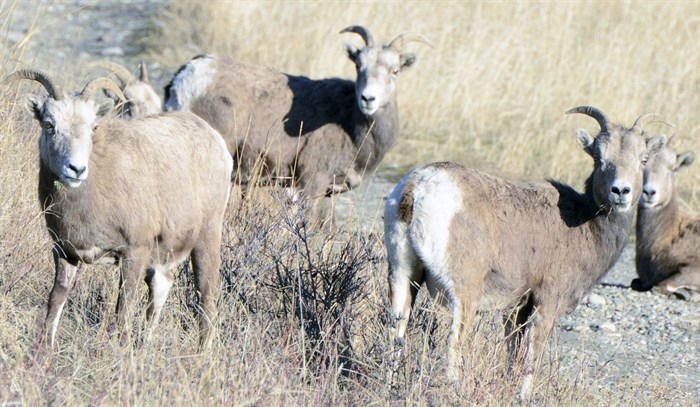
Washington State authorities have now found a mite which results in psoroptes or sheep mange in animal populations in the eastern Okanagan Valley.
Image Credit: Mark Brett, Local Journalism Initiative
August 14, 2023 - 10:30 AM
Agencies on both sides of the border are working to help bighorn sheep after learning about the spread of a devastating disease this year.
In an “Early Warning Note” from the BC Ministry of Forests to government officials, it was reported that psoroptes mange has now been found in the eastern Okanagan Valley bighorn sheep.
It was first discovered in the Okanagan in 2011 near Keremeos. The disease, caused by mites along with a pneumonia infection (M. Ovi), is blamed in part for as much as a 60% decline in the population.
The Washington State Fish and Wildlife Agency found psoroptes in 2023 in sheep populations known to travel between the U.S. and east Okanagan.

This photo shows sheep infected with psoroptic mange, circled in red, next to an uninfected sheep, circled in yellow.
Image Credit: Mark Brett, Local Journalism Initiative
Prior to that discovery, there had been no documented cases in those herds.
Bighorn populations have largely been separated east/west across the Okanagan through urban sprawl, high fences and large lakes.
“Wildlife staff anticipate this outbreak may create additional challenges for an already stressed, culturally and economically significant species,” wrote Shellie Saunders, executive administrative assistant for the Ministry of Forests South Area in the report.
The infestation doesn’t kill the animals directly, but is believed to weaken them and make them more susceptible to other health issues.
“It’s a disease that definitely hurts their body condition and can inhibit their ability to hear predators and traffic,” said Okanagan Nation Alliance (ONA) biologist Mackenzie Clarke, who has been working on the problem. “These (east Valley) populations are already under very stressful conditions and then to add this disease is very bad.
“I think right now we need to work on a new strategy. There’s a new version of the drug to treat the disease, but it will be very labour intensive so we’re going to have to make sure it’s 100% effective.”
Since discovered, First Nations, government and non-government agencies have been working together to combat the problem.
That included a 2017 trial program by the Penticton Indian Band where animals were caught and kept in pens while being treated. It had some success.
“So that’s potentially the approach we’re going to take again,” said Chris Barker, vice president of the Wild Sheep Society of BC, one of the lead conservation groups in the matter. “There has been some progression in the science around treating psoroptes and what we’re hoping to do is another trial and, if it works, then we have a plan in place where we could possibly treat all the populations on both sides of the valley.
“For these animals, it’s just something else they’re dealing with, but if we can get ahead of it a little bit, maybe we can get to a positive outcome and re-establish populations to better keep those sheep populations in the Okanagan.”
South of the border, in addition to the Washington Fish and Wildlife Agency, the society is working with the Colville Confederated Tribes and the Washington Wild Sheep Society.
— This story was originally published by the Penticton Herald.
News from © iNFOnews, 2023